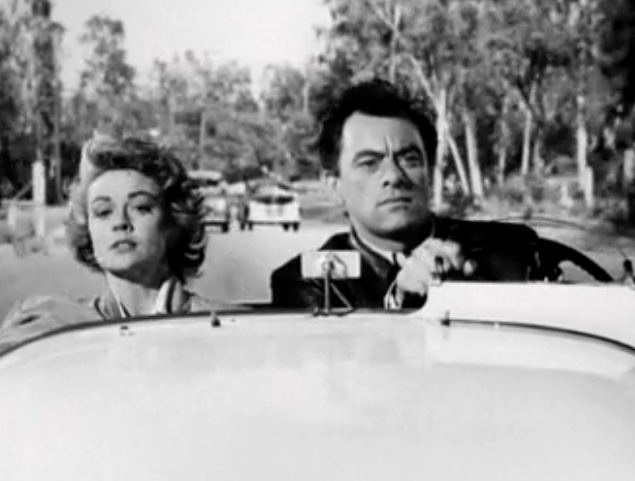The mid-1900s was a time when film was still working its way into being less conservative for certain thematic material. Unlike today, when somebody hears the term "fast" or "furious" in the same sentence, many people think of the Universal Studios' billion dollar franchise that has soared to endless heights with its insane car stunts and character driven writing. Jumping back into the middle of the 20th century there's this film that Universal had acquired the title rights from and it's important to understand times were much different then. Not only is it super tame in its action and stunts but several other elements are slimmed down as well. Kiss those 130-blockbuster minutes goodbye, this feature rolls in at a tiny 72 minutes; barely enough to pass as a theatrical film these days. Believe it or not, these points don't sound promising but the film does stand on its own. It's just not anything beyond a one-time watch.
 |
| Yeah, most of the background effects aren't great but they tried |
The story is about a wrongly convicted truck driver named Frank Webster (John Ireland) who is trying to escape to Mexico before the authorities can get a hold of him. Upon leaving a diner, he takes a lady named Connie Adair (Dorothy Malone) and her brand new Jaguar cruiser hostage in order to escape quickly enough from being arrested. The film was directed partially by main actor John Ireland and Edward Sampson; both of which were relatively new to directing. This was Sampson's first credit, Ireland's second and their last for both. For directing quality, it's focused but more or less uninspired. The script that was originally conceived by Roger Corman and then adapted by Jerome Odlum and Jean Howell is slightly better because the viewer will get an understanding of how and why Frank Webster is who he is. Also, those who fondly enjoy The Fast and the Furious (2001) will be able to see what pieces of the script of this film were lifted from. Other than the title and fast cars; sabotaging trucks, street races and wrongly convicted individuals go hand-in-hand with that of the 2001 film.
The screenplay still has its problems though with character motivations and dialog. Most likely due to the short run time, the speed at which characters change their opinion on certain matters feels unnatural or is just illogical. The problems with the dialog are simple to notice too. Much of the dramatic heft and delivery of lines range between cheesy 50s acting to stiff as a board. The cheesiness comes from when police officers are trying to get information from a suspect and it feels overly silly. The actor that is the most rigid in their role is surprisingly John Ireland. Considering Ireland had practically a decade to hone his acting chops, his deliver is emotionless here. Plus, what may be annoying to some viewers is that Ireland's character was written to always have the last word in a conversation. Yes, we understand Frank Webster is not a man to be messed with, but making him get in the last word to every conversation makes him sound immature.
For racing action, a lot is seen that it is all stock footage. For 1955, people most likely believed or found this to be adequate special effects. For today's standards of course not, but it should be appreciated for what is depicted and the effort that went into making it look as realistic as possible. There are some moments where producer/writer Roger Corman did act as a stunt driver and its not the easiest to tell actually. The time when Corman is a stunt driver is about as equally concealed as to today's films that try to hide certain stunts into a film. Either way there is some swift moving, sleek looking cars shot in this movie. If there's one thing this film highlights, it's how races used to be conducted back in the 1950s. Something of which many people don't see anymore and is a much different experience. There are also some crash and burn moments too but again, it is much less than what today's audiences have seen.
 |
| That scowl is on John Ireland's face practically the whole time |
The cinematography handled by Floyd Crosby was decent too. Crosby, best known for working on House of Usher (1960) along side Corman demonstrate his ability to keep the camera focused on what's important on screen. Unfortunately it does suffer from shaking occasionally but not from today's "shaky-cam" issues. The problem arises more from the fact that some shots are filmed of which looked like the camera was physically on the back of a car. At that point in time back then, it is most likely that the right technology hadn't been created yet, or the budget did not allow for such fancy gadgets. But for as problematic as it may sound, those shots are actually the best because they feel the most real in the film without using green screen or other cheap effects. The music composed by Alexander Gerens was okay. It wasn't anything special with a main theme but it did give the film that classic 1950s sound that only a certain era of film making could provide. Can't knock that.
It's by no means even a very involving film, but it does have decent effects, camera-work and music. It also showcases retro cars along with other things that are different from that time. It's screenplay even gives somewhat of an understanding to where the parts in The Fast and the Furious (2001) came from. However, the rest of writing has shifty character motives and some unimpressive acting. At least it's only an hour or so long; it'll go by quick.
Points Earned --> 5:10


No comments:
Post a Comment